Anna's Colombia Journal
Posted: 08 May 2018
In April 2018, Keylink’s Marketing team member Anna Burnell spent a week in Colombia with Luker Chocolate. There she discovered the diversity and spirit of this vibrant South American country, and the work Luker Chocolate are doing to further the cocoa industry and, in doing so, improve the infrastructure of a region that has seen its fair share of challenges. This is her journal of her adventure.
Day One: Monday 23rd April 2018
On landing in Bogotá, Colombia’s capital, in the early morning sunshine and climbing into a mini bus, my first impression of this new country was of crazy driving rules! Lanes seemed to be there to be ignored, with traffic feeding in from all directions and horns beeping left, right and centre! It did a great job of waking us from our groggy, post-flight state.
Paul and David from Luker Chocolate UK greeted us at the hotel and a couple of restorative hours later we were met by Stephanie and José from Luker Chocolate Bogotá, and whisked off for a coach tour through the city. I was too awake to feel tired; there was so much colourful street art to take in, people watching to do… and innovative driving styles to avoid looking at!
We disembarked in downtown Bogotá and the next thing we knew, we were queuing for a cable car to carry us up 10,341 feet to Monserrate Church. The cables looked too unnervingly slack to take the weight of our entire party but that they did, together with a few locals – one of whom was taking a Yamaha keyboard up with him…
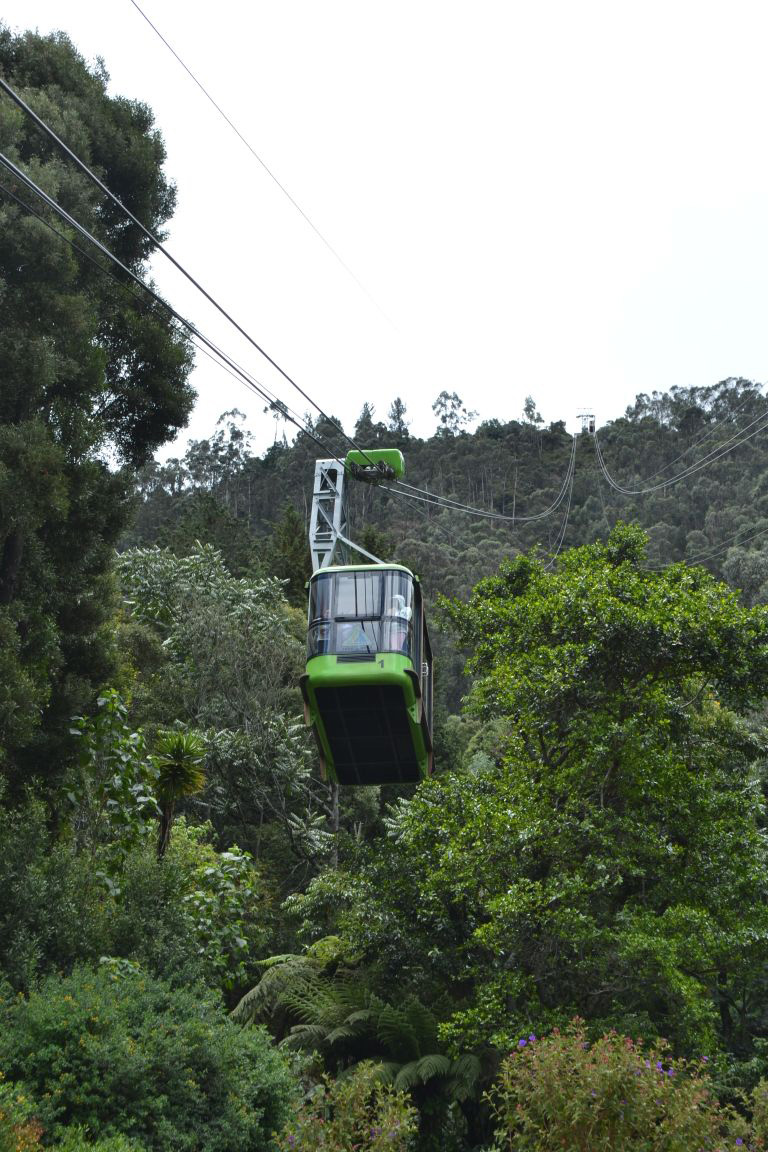
The cable car gave us a fantastic and unique view across the vast city. The altitude was so great that we struggled to breathe – just a few feet up some steps and we were all panting. We visited a small market high up on that mountain where we sampled coca tea, made with the leaves of the native South American coca plant. Mine was sweetened with panela sugar. The claim is that the combination of the tea and sweetness of the panela help with dizziness from the altitude and boost the energy. It may have been simply the sugar, but I certainly felt more alive after drinking it.
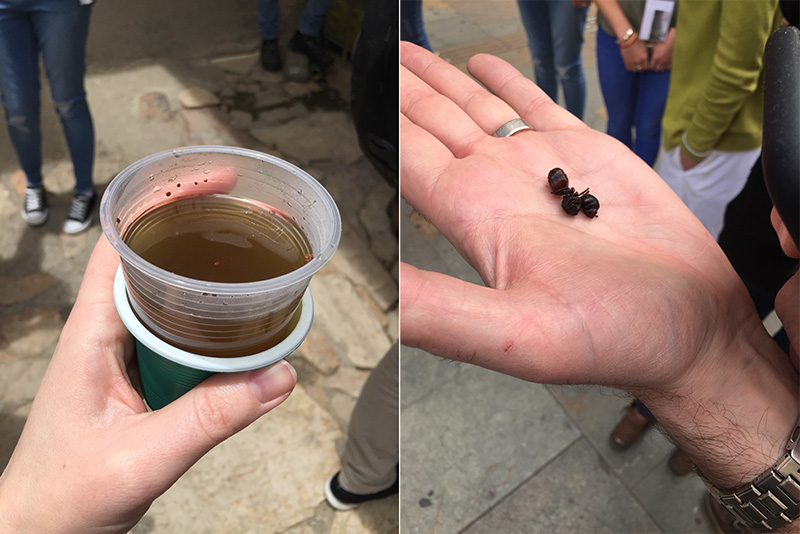
The weather up there was strange; in the full sun it was a blazing, unblinking heat, yet when the sun swept behind a cloud, suddenly we were chilled and zipping up jackets.
Once we were down at a sensible height again we took a short walk through the streets of Bogotá and visited a very relaxed restaurant serving traditional Colombian food. We received such a warm welcome – which, we were to find out, would be a trend that entire week, wherever we went – and the staff all came out to greet us and give us friendship bracelets in the colours of the Colombian flag. The manager translated the menu while we tucked into jugs of ale, and I chose a paella made with clams and calamari and served with mango salad and brown rice – so delicious and fresh.
Pleasantly full and feeling I’d got to know others in the group better over shared drinks and food, we took to the streets once again for more sightseeing. Our tour guide was passionate about Bogotá and went to great lengths to ensure we got a good overall picture of the city’s history. One of his stories was interrupted, however, by Stephanie stopping to buy a snack of ants from a street seller. Around half the group enthusiastically gave them a go. I might have felt a little braver had there still been a glass ale in front of me to wash it down with!
After stopping in a square to see the impressive presidential buildings – and get rather sunburnt in the process – it was off to a coffee shop for some real Colombian coffee and a selection of local cakes.
While we were waiting at a busy roadside for our minibus to pick us up, we saw countless mopeds speed past, all beeping their horns to warn anyone foolish enough to consider crossing the road, and public buses packed to the beams with people, and with even more people riding by clinging to the outside.
Day Two: Tuesday 24th April 2018
Up nice and early and off we went to the airport in Bogotá. The excitement in our bus was palpable – today was the day we went to Granja Luker, Luker’s research and education centre, and that meant… cocoa pods! Our first internal flight of the week took us to Pereira, where we noticed an immediate rise in temperature when we stepped out of the airport, but it wasn’t unpleasant. It gave us all the ideal and very British opportunity to look like we were participating in a straw hat competition.
The drive from Pereira to Granja Luker took around ninety minutes and was a chance to sit back on an air-conditioned coach and start to take in the lay of the land as we passed through the lush countryside. Francisco Gómez, Luker’s Business Development Director, explained how we were passing through coffee growing lands, and then cocoa. When our coach stopped for fifteen minutes for roadworks, roadside sellers flocked, and Francisco purchased snacks, including green mango slices with salt for us to try – so refreshing and tasting very much like tequila!
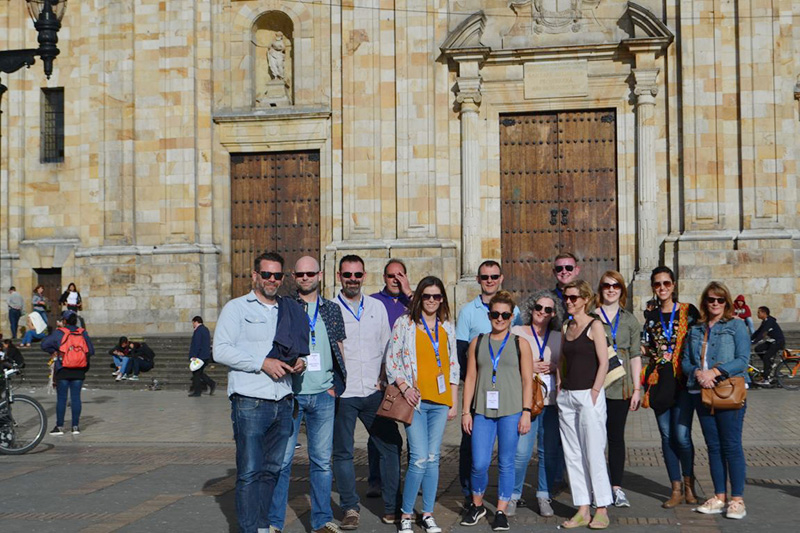
We had all seen so many photos of Granja Luker, so it was incredibly exciting to see it in real life! We received a very warm welcome on arrival. Cocoa pods were happily growing right there in front of the main building, so we were very quick to go up to them, cameras in hand. Lunch was corn cakes (arepas), beans, rice, chorizo, avocado and mince, with eggs on top. Very much like the Colombian version of the perfect English breakfast!
An hour in an open-sided classroom with a perfect view of the cocoa trees taught us all about different cocoa varieties, planting methods and an explanation of the science behind cacao growing, and the work carried out at Granja Luker. It was interesting to hear how Luker openly share their methods with anyone willing to learn – even competitors – as they believe the value of the work they do is greater than all of us.
After some hands-on learning about how to strip, cut and graft two cacao seedlings together to create one productive plant, we got our first chance to taste cocoa bean pulp straight from the pod. It was fascinating how different the pulp tastes depending on the pod variety, some slightly acidic and some as sweet as lychee.
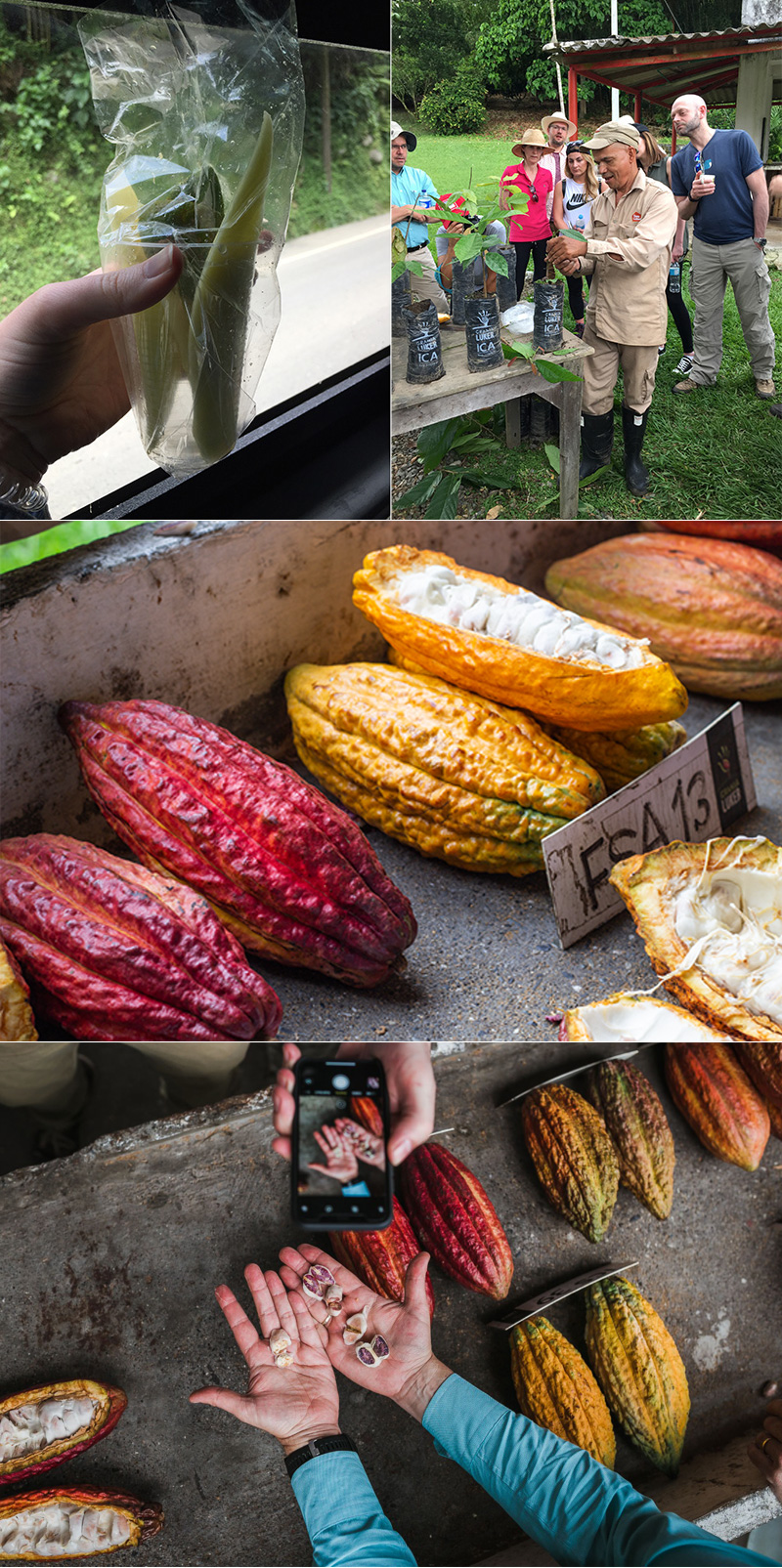
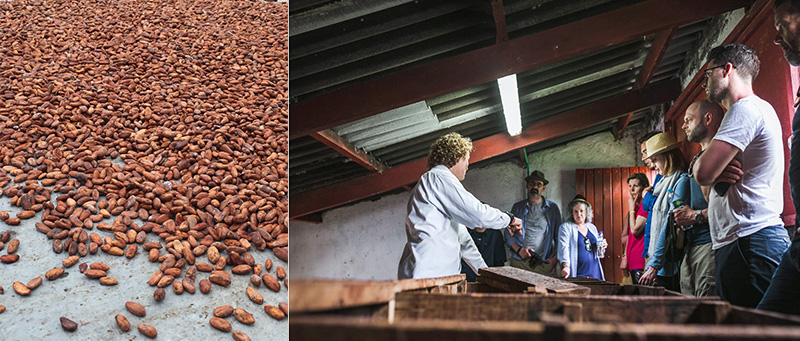
Next, we set off to see the plantation itself. Fortunately the weather was dry, though the mosquitoes were out in force! This was the true magic of Granja Luker for me. Being amongst the cacao trees, able to touch the pods and see Luker’s model of growing tall melina wood trees, cacao trees in the shade of the wood, and then plantain or bananas for a faster yield was very inspiring. I could see exactly how they use the model to demonstrate the earning potential to aspiring and existing cocoa farmers.
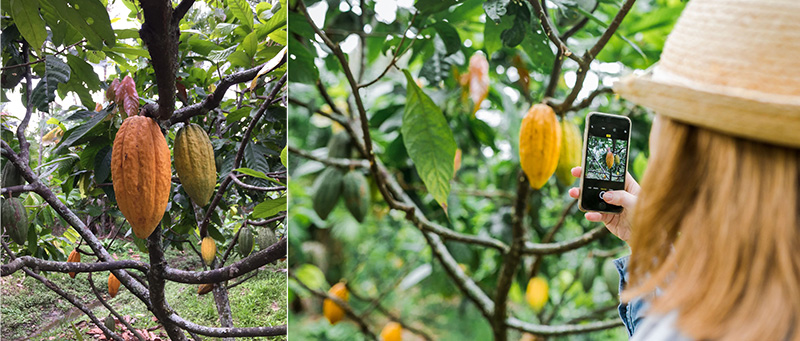
The plantation is a very serene setting, where the trees work in harmony with the insects, and the workers seem very content, cultivating and caring for the crops. We were fortunate enough to meet some of them, and they told us how proud they were to work for Luker and be able to impact the landscape they care for. They helped us to plant cacao saplings – it was a very joyful moment for me being photographed next to my very own cacao tree!
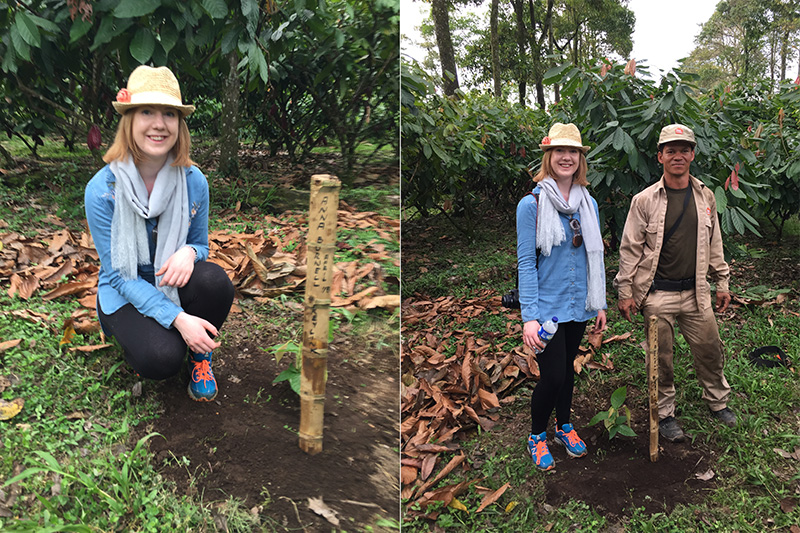
That evening our hosts prepared an enormous barbecue of steak and sausages with potatoes, and we all ate under the stars, surrounded by backlit cacao trees and listening to a local salsa band and, later, the chirruping of crickets. It felt as though time stood still, and it was the perfect setting to sit and reflect on what a special and significant place Granja Luker is.
Day Three: Wednesday 25th April 2018
Breakfast was back at Granja Luker at 7am, and then our coach carried us off somewhere that was to be a complete education for me: a coffee plantation. We were treated to an amazing view out across the hills from the farmer’s house, and then we were directed towards two jeeps. This struck us as a little odd, as we knew there were far more than two jeeps’ worth of us! All became clear when it was explained that we needed to climb into the open backs of the jeeps, stand on the bench seats, and travel holding on to pretty much anything we could reach. We travelled with the wind in our hair, being shaken to death but with enormous grins on our faces. It was the ideal way to see the countryside, and we joked that this was an experience we would never get away with repeating on public roads back home!
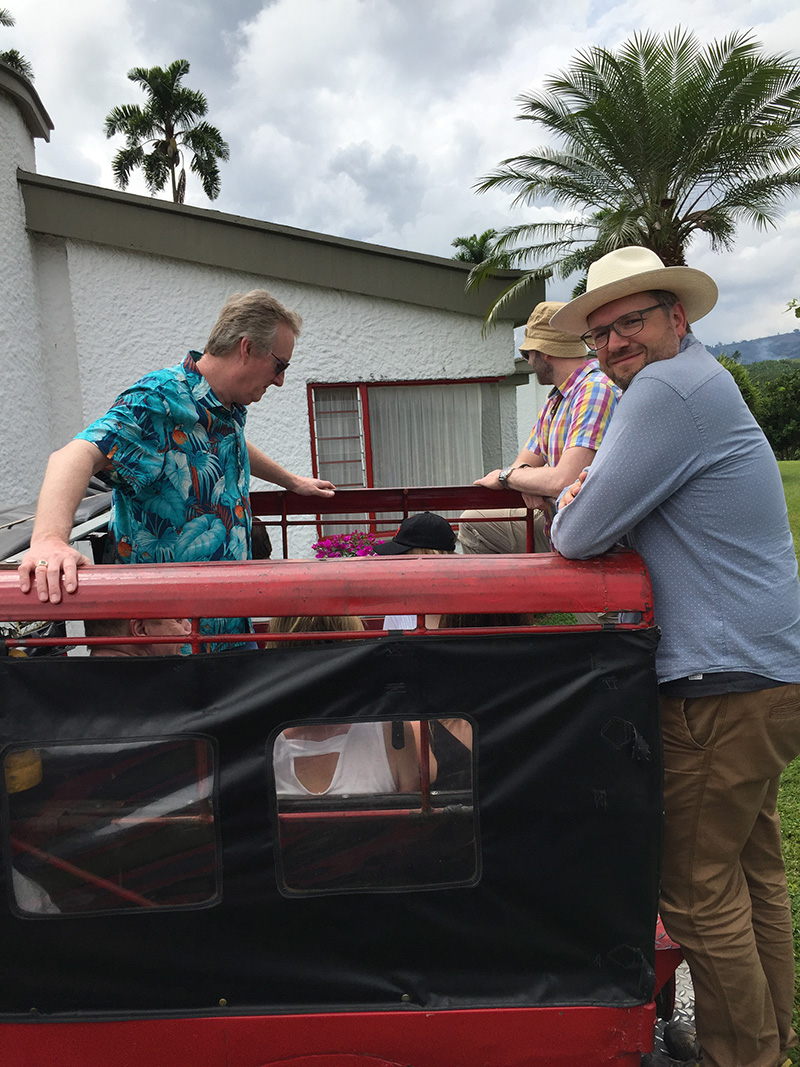
.jpg)
Seeing coffee beans growing on the plants was a new experience, and though I knew little about the coffee making process, it was interesting to see how it differed from cocoa, and how world-famous Colombian coffee comes to be. The beans taste very sweet straight from the plant, and we saw how they are individually hand-picked (back-breaking work), washed, dried, and how the waste turns into the most fantastic compost!
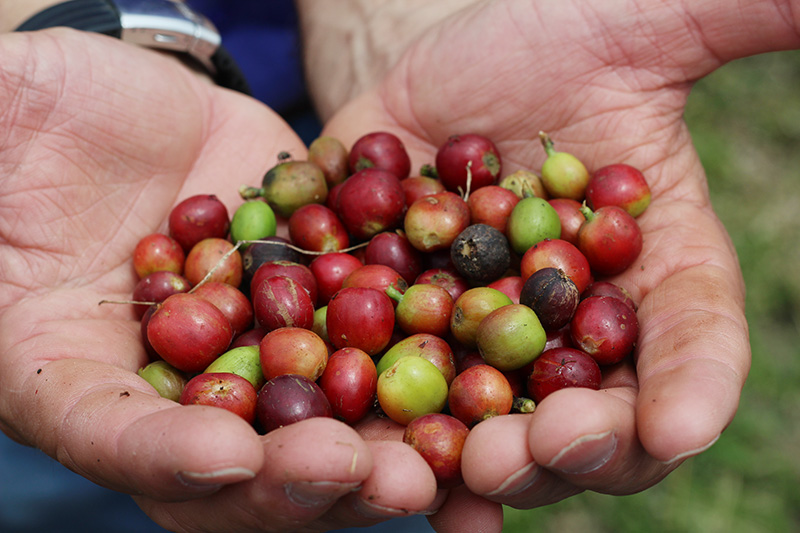
We had lunch at “Hacienda San Nicolás” a villa where we were once again treated like royalty and served a delicious homecooked meal. We were in the open air but under cover, which was fortunate as this was the first time we saw rain… and when it rains, it really rains!
Before we knew it, it was time to hop back on our coach and head back to the airport, ready for our flight back to the capital.
That evening Luker took us out for a meal at Chicheria Demente, a restaurant with a rustic warehouse-like setting where we could see the food being prepared and dish after dish was presented to us. The fresh prawns and steak proved very popular with our group, and great enthusiasm was shown for the chocolate melt in the middle pudding, especially when our hosts had checked the brand of the chocolate used!
Day 4: Thursday April 26th April 2018
The next morning dawned bright and sunny and we zipped off to the Luker factory in Bogotá. It was fantastic to taste different origins of cocoa mass so we could discern the flavour differences between the raw mass and the finished chocolate, and how different roasting times affect flavour. I never get bored of learning more about cocoa flavour variation, so I felt right at home. We also had a quick tour round the site, calling in at the bean storage room. It was gigantic and stacked up to the ceiling with sacks of beans. The entire store holds just three weeks of production!
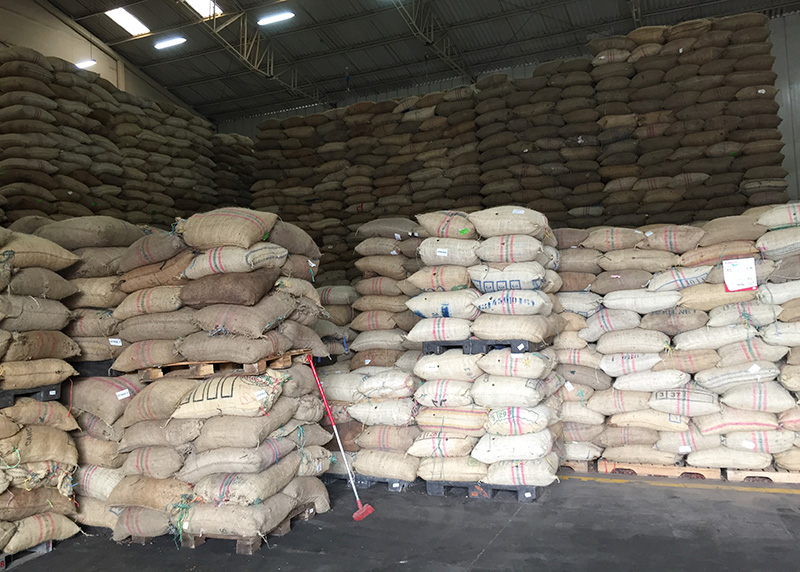
After a speedy lunch we hopped on another internal flight, this time to Monteria, inland on the West side of the country. An hour later we stepped into an even greater temperature hike than the first, and the air was thick and humid. Piling into two mini buses, we travelled for two and a half hours out of the town and across the countryside towards the coast. Sleep was creeping over me after the flight but I couldn’t even think of closing my eyes for a second; the landscape was changing so quickly all around us and there was so much to take in. Houses were more spaced apart and shack-like, the cows were noticeably thinner, unlike the well-fed friesians we had left behind around the capital. We passed families sitting outside in hammocks, and children playing barefoot in puddles. A blacksmith sent sparks flying out into the road in one small village. Cars became less frequent the further we travelled, and roadside stalls selling plantain and pineapples grew in number, while the landscape remained lush and green.
Eventually I glanced right and saw the ocean right there, blue and imposing, just feet from the bus window. Palm trees started popping up and buildings became more rudimentary still.
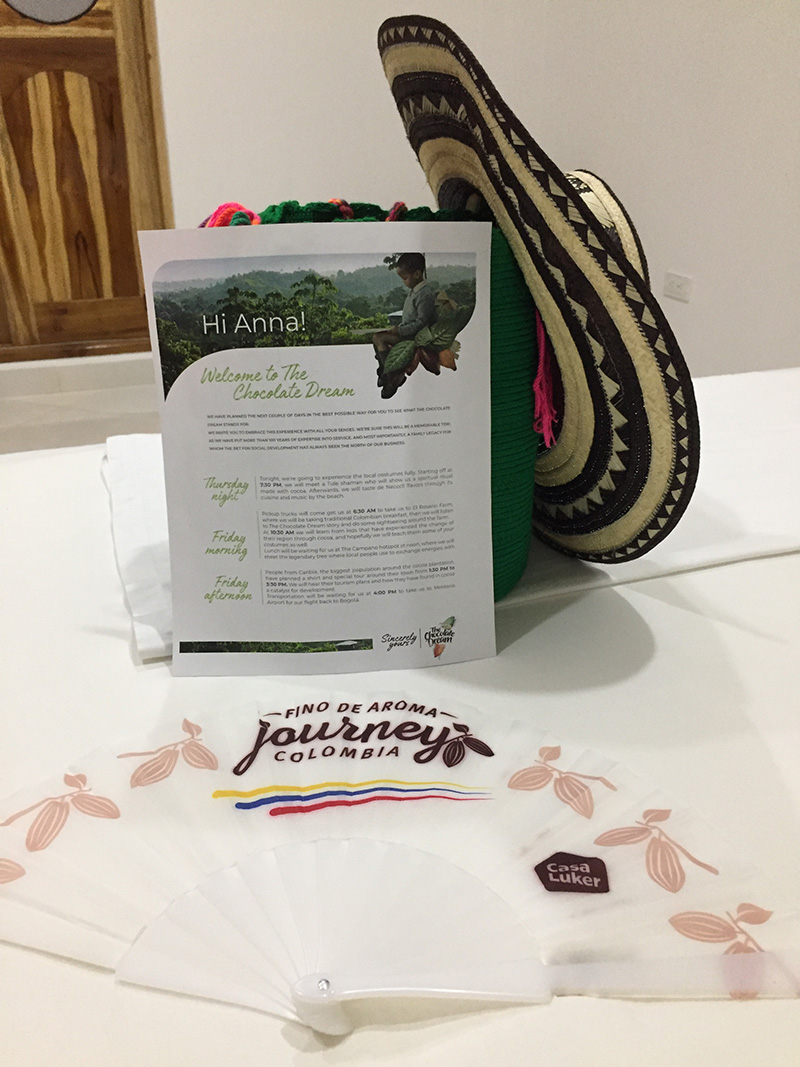
Half an hour later we were there, unbelievably, on the Caribbean coast. It was raining hard but it was very tempting so run barefoot round the streets, it was so warm. We drew up at a recently opened hotel where we received an enthusiastic welcome and found beautiful locally crafted hats and bags waiting for us on our beds. Personalised notes welcomed us to Luker’s The Chocolate Dream and promised us a fully sensory experience.
What is The Chocolate Dream?
The Chocolate Dream is an invitation to dream from Luker. A long term vision to drive change in cocoa-producing regions of Colombia. A project where innovators, entrepreneurs, academics, NGOs, companies and passionate dreamers are welcomed. It is a project made up of 15 ideals, collectively aiming to effect change in Colombia’s rural development. The Chocolate Dream in Necoclí is an opportunity and motivation to take advantage of the power of cocoa to transform and positively affect the community.
After befriending a small lizard and deciding showering was more of a courtesy than a useful exercise at this point, we were taken to a beachside bar just yards down the road, where the magic began. We were invited to sit in a circle on rush mats in the candlelight, before being handed fresh coconuts to drink from and being introduced to a Tule shaman and his wife – grandparents of a community member, who demonstrated a spiritual ritual made with cocoa. It was an unearthly moment indeed, sitting with our eyes closed, while the ocean lapped gently at the shore nearby and the shaman chanted in the flickering candlelight. We all felt very honoured to have been welcomed so readily into a community that had until recently mistrusted outsiders, many whom had come into the area making promises to start new, beneficial enterprises, only to leave soon after. We began to understand the impact that Luker’s The Chocolate Dream had had on an area so torn apart by war and drugs and generations of unemployment, though we were warned that these were subjects we would never hear the locals talking about.
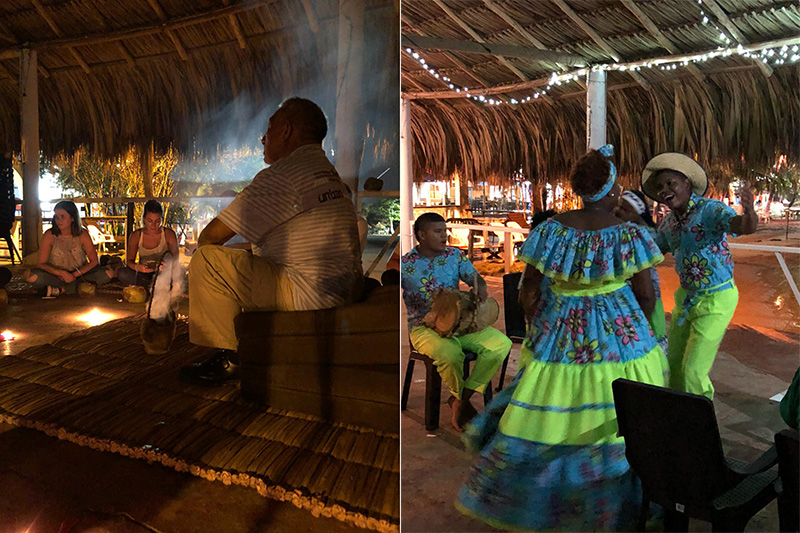
Following the ritual we ate fresh prawns in coconut sauce with rice and plantain, and were entertained by a local music and dance group, dressed in traditional, vibrant costume. Art painted by community members was on display around our table. It was a truly enchanting evening.
Day 5: Friday 27th April 2018
A 6.30am start, but not before I had nipped out to take a few snaps of the shoreline in the daylight. Unfortunately it was still raining, but it was soon to turn into a dry and blazing hot day.
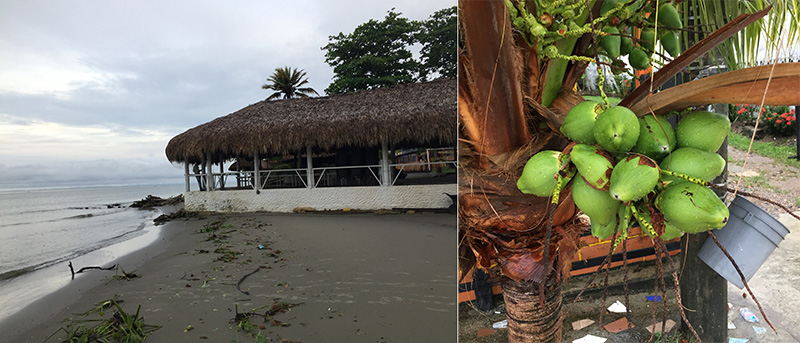
Land Rovers arrived to take us to El Rosario farm. At 550 hectares, the land used to be a cattle farm with few trees and employing only a couple of cattle farmers. The area was in its third generation of unemployment. Today it is Colombia’s largest Fino de Aroma cocoa farm, designed on the same agroforestry model as that we had seen at Granja Luker, and employing more than one hundred and fifty people. Some have even left the armed groups they were involved with in order to work for the project.
A presentation at the farm introducing us to The Chocolate Dream primed us for what we were about to experience that day and after a tour round the farm where we could see the beans drying and then fermenting, we set off for our next stop. I was really looking forward to seeing just how cocoa translates into an improved, happier society.
The previous evening Juana from Luker had explained to us that one of the saddest effects of the issues the region had faced had been how withdrawn and traumatised the local children had become. She told us that just a year before, the children wouldn’t play or look them in the eye when they visited the schools, and were extremely timid. I was very much bearing this in mind when I saw on the itinerary for the day that we were going to be visiting a local school, so it was a fantastic surprise when we arrived at Buenos Aires School and were swarmed by bright, laughing happy children hugging and kissing us and saying good morning. It was an emotional moment seeing how the children reacted to Juana, who has invested a lot of time in the children, and it was a great example of how The Chocolate Dream is impacting lives and building trust in the next generation.
We were swept on a sea of giggles into the classroom, where we chatted with the children about our home countries and showed them their location on a wooden atlas. Hearing the children singing and telling us enthusiastically about what they would like to be in the future (lots of doctors, teachers, footballers and one aspiring fairy!) was one of the real highlights of the trip for me. We heard how when it rains a lot, many local parents keep their children home from school as the walk is dangerous and they won’t risk their uniforms becoming dirty. Luker has invested in bicycles for the children, but better still for travelling through the mud are donkeys, which are their current fundraising focus.
After a group photograph and waving the children goodbye, we ate lunch right in the middle of the plantation; meat, beans and rice wrapped in a plantain leaf - a typical plantation worker’s lunch and incredibly satiating. We met some of the workers and were once again inspired by their stories of how they had progressed, self-motivated but also encouraged by Luker. Eating at a large wooden table amongst such biodiversity and the sounds of the forest was an experience we all knew we couldn’t recreate by watching a video. The very floor was alive beneath our feet, and our environment had the same tranquillity we had felt at Granja Luker.

In the afternoon we visited a small village called Caribia, a community benefiting from The Chocolate Dream. The welcome we received was overwhelming! All generations poured out to greet us, and we were presented with jewellery made from local reeds, and handmade, hand decorated baskets made from fruit. We were the first tourists to visit the village and so were made to feel incredibly special.
After a welcome speech we received a tour of the village, seeing how the reed jewellery is made and where the reeds are grown, seeing how villagers cross the river on a wire pulley and being shown the home of our guide, and the local shop she manages. She had recently had the opportunity to complete a course in tourism, which will allow her to welcome more visitors to experience their way of life and raise the profile of the community. We also met her ninety-five year old grandparents. All the while the local children skipped around us and asked us questions, which we did our best to answer in Spanish. We were introduced to local macaws and presented with fresh coconuts and cake while we watched the children’s football team play – no mean feat in baking temperatures!
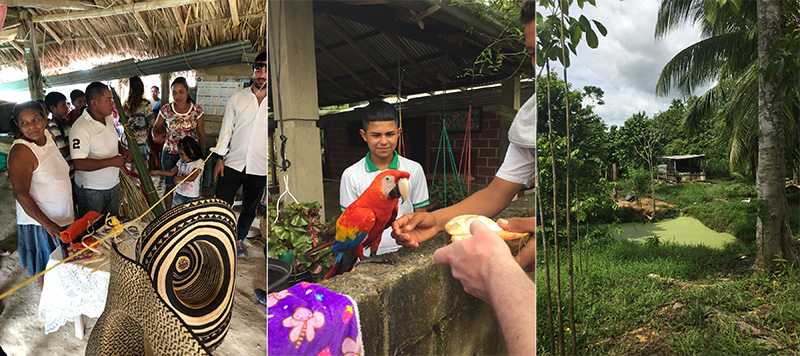
After lots of photos together, thanks and hugs we departed Caribia wearing big smiles. The Chocolate Dream is enabling Caribia to develop new sources of income through tourism and craft, and it was clear to see from their welcome how much the project’s impact is appreciated.
We left Necoclí tired, but as we travelled the two hours back to the airport I reflected on how lucky we were to be so welcomed in a region that had – for good reason – mistrusted outsiders until now, and how much effort from so many it will have taken to cause us to be received with such open arms wherever we went. Cocoa, I began to realise, is very powerful stuff indeed.
Day 6: Saturday 28th April 2018
I woke up sure I’d been dreaming of brightly coloured parrots! Our time in Colombia was almost over, but there was still time for a few more surprises.
After what felt like a very lazy start compared to the early mornings of the rest of the week, we met with our suitcases packed and were taken by special request to the emerald quarter of Bogotá. I hadn’t realised that many of the world’s emeralds are mined in Colombia, so it was fascinating to receive a quick talk on how the emeralds are sourced, shaped and refined.
We then travelled quite a distance outside of Bogotá for lunch. It soon became apparent that the distance was well worth it when we arrived at the phenomenon that is Andrés Carne de Res. It is highly eccentric, the size of a small town, employs over a thousand staff and is what can only be described as a fantastically bonkers eating experience! Visually, it’s a real assault on the senses, with so much décor to take in that I felt the need to take photos so I could study them in stages later. The food was absolutely delicious, and the only time I looked up from my meal was when a troupe of Alice’s Adventures in Wonderland characters paraded past our table and confetti landed on my steak.
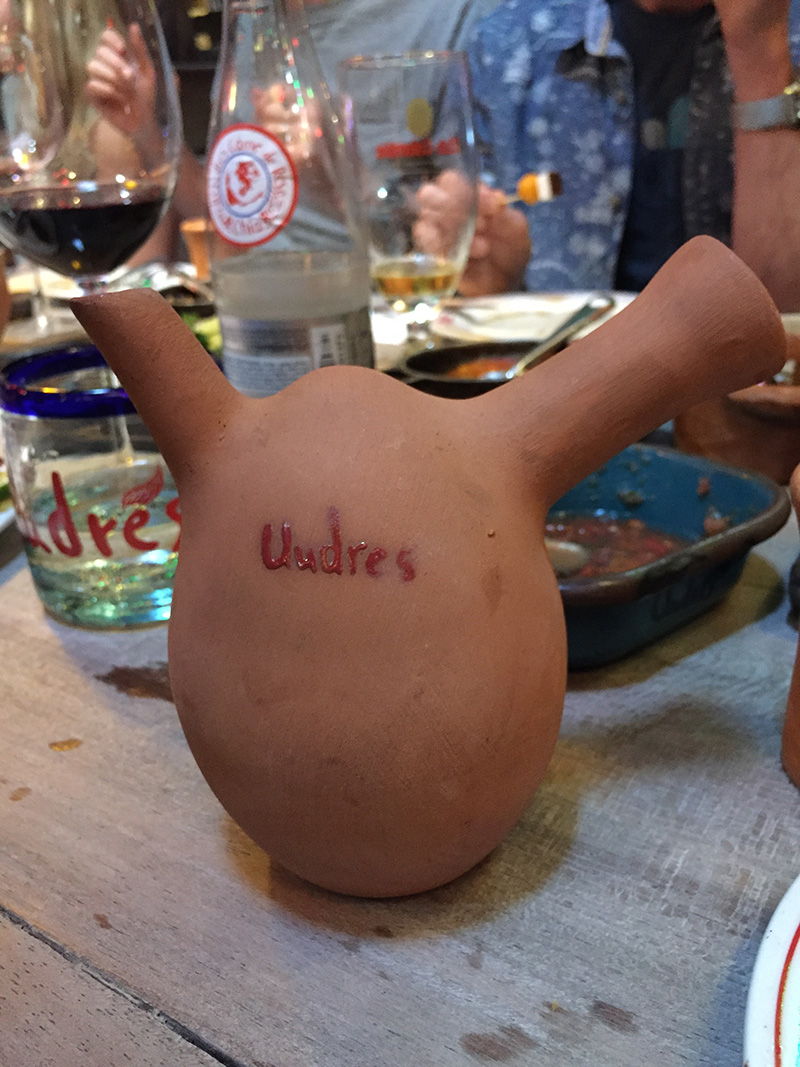
And before we knew it, we were heading to the airport.
Colombia is a country that never stops surprising you. So alive, so diverse, and with a real sense of fun and adventure. And yet the impact of unemployment, poverty, social unrest and the drug trade is still very evident in the region we visited. This makes the positive changes happening as a result of the projects that make up The Chocolate Dream shine all the brighter in contrast. To experience that is to want to see those changes grow and develop, bring about greater change across Colombia, and to see Luker’s model for change implemented across other communities worldwide, and the global cocoa trade.
The Chocolate Dream is something in which we can all participate.
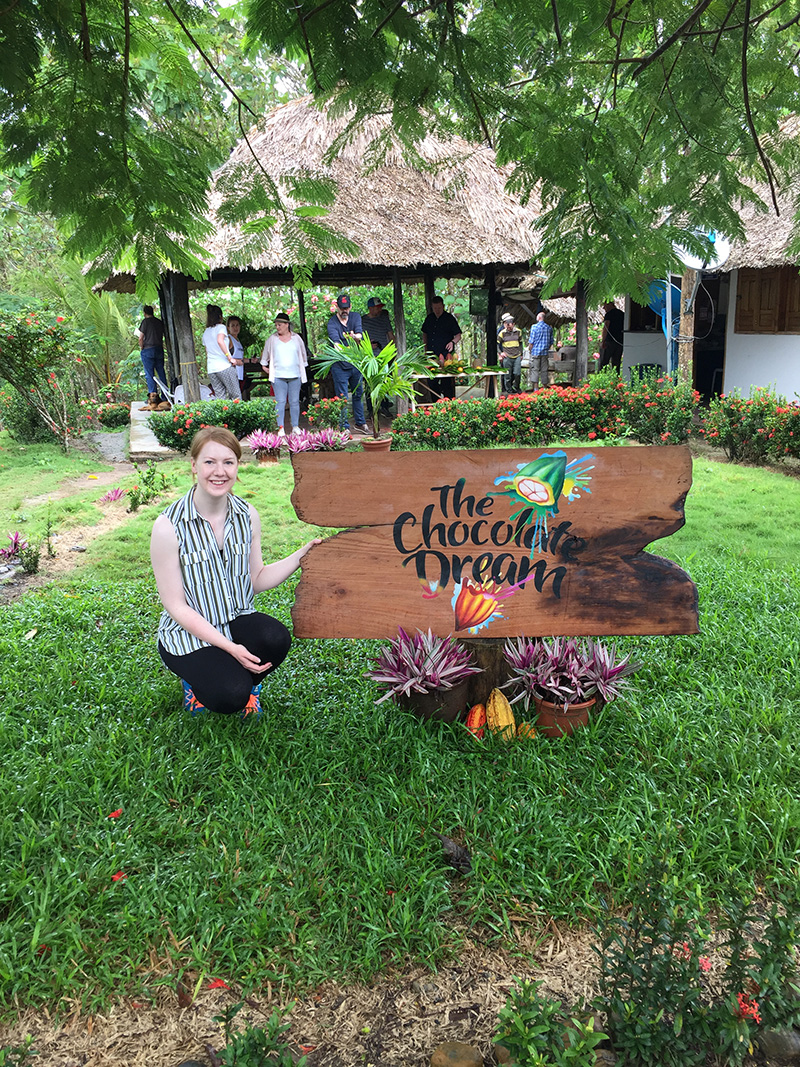
.svg)